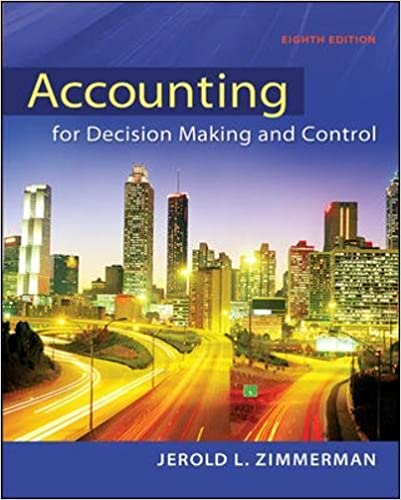
Accounting for Decision Making and Control 8th Edition by Jerold Zimmerman
Edition 8ISBN: 978-0078025747
Accounting for Decision Making and Control 8th Edition by Jerold Zimmerman
Edition 8ISBN: 978-0078025747 Exercise 24
Magic Floor
Magic Floor produces and sells a complete line of floor care products: wax strippers, floor soaps, and floor waxes. All of these products are packaged on a new high-speed bottling fill line. Empty bottles (pints, quarts, half gallons, or gallons) are automatically removed from their boxes and placed on the line. The empty bottles are then filled, sealed with a foil closure, capped with a screw, and labeled. The filled, sealed, capped, and labeled bottles go to a weigh station to ensure each bottle has the correct amount of fill, and the nonrejected packaged bottles are placed in boxes and a bar-coded shipping label is attached. The fill line requires minimal direct labor once it is programmed for the bottle size, contents, and the bar-coded labels. The decision to purchase the fill line in 2010 was justified under the assumption that the line would run 7 hours a day, 5 days a week, and 50 weeks a year.
The 2012 budget for the fill line is:
 Magic Floor's 2012 budgeted production is:
Magic Floor's 2012 budgeted production is:
 Magic Floor allocates the fill line costs to the various bottled products using a predetermined overhead absorption rate calculated based on budgeted costs divided by budgeted volume. Budgeted volume is measured in seconds on the fill line. Pints are filled in 3 seconds, quarts in 5 seconds, halfgallons in 9 seconds, and gallons in 17 seconds.
Magic Floor allocates the fill line costs to the various bottled products using a predetermined overhead absorption rate calculated based on budgeted costs divided by budgeted volume. Budgeted volume is measured in seconds on the fill line. Pints are filled in 3 seconds, quarts in 5 seconds, halfgallons in 9 seconds, and gallons in 17 seconds.
During 2012, the following times (in seconds) were recorded for filling bottles on the fill line:
 Actual overhead costs incurred in 2012 on the fill line are:
Actual overhead costs incurred in 2012 on the fill line are:
 Required:
Required:
a. Calculate the expected volume of the bottling fill line for 2012.
b. Calculate the normal volume of the bottling fill line for 2012.
c. Calculate the overhead absorption rate for the bottling fill line for 2012 based on expected volume (round overhead rate to four decimals).
d. Calculate the overhead absorption rate for the bottling fill line for 2012 based on normal volume (round overhead rate to four decimals).
e. Calculate the over/underabsorbed overhead amount for the bottling fill line for 2012 based on expected volume.
f. Calculate the over/underabsorbed overhead amount for the bottling fill line for 2012 based on normal volume.
g. Explain in intuitive terms why your answers in parts ( e ) and ( f ) differ.
Magic Floor produces and sells a complete line of floor care products: wax strippers, floor soaps, and floor waxes. All of these products are packaged on a new high-speed bottling fill line. Empty bottles (pints, quarts, half gallons, or gallons) are automatically removed from their boxes and placed on the line. The empty bottles are then filled, sealed with a foil closure, capped with a screw, and labeled. The filled, sealed, capped, and labeled bottles go to a weigh station to ensure each bottle has the correct amount of fill, and the nonrejected packaged bottles are placed in boxes and a bar-coded shipping label is attached. The fill line requires minimal direct labor once it is programmed for the bottle size, contents, and the bar-coded labels. The decision to purchase the fill line in 2010 was justified under the assumption that the line would run 7 hours a day, 5 days a week, and 50 weeks a year.
The 2012 budget for the fill line is:
 Magic Floor's 2012 budgeted production is:
Magic Floor's 2012 budgeted production is: Magic Floor allocates the fill line costs to the various bottled products using a predetermined overhead absorption rate calculated based on budgeted costs divided by budgeted volume. Budgeted volume is measured in seconds on the fill line. Pints are filled in 3 seconds, quarts in 5 seconds, halfgallons in 9 seconds, and gallons in 17 seconds.
Magic Floor allocates the fill line costs to the various bottled products using a predetermined overhead absorption rate calculated based on budgeted costs divided by budgeted volume. Budgeted volume is measured in seconds on the fill line. Pints are filled in 3 seconds, quarts in 5 seconds, halfgallons in 9 seconds, and gallons in 17 seconds.During 2012, the following times (in seconds) were recorded for filling bottles on the fill line:
 Actual overhead costs incurred in 2012 on the fill line are:
Actual overhead costs incurred in 2012 on the fill line are: Required:
Required: a. Calculate the expected volume of the bottling fill line for 2012.
b. Calculate the normal volume of the bottling fill line for 2012.
c. Calculate the overhead absorption rate for the bottling fill line for 2012 based on expected volume (round overhead rate to four decimals).
d. Calculate the overhead absorption rate for the bottling fill line for 2012 based on normal volume (round overhead rate to four decimals).
e. Calculate the over/underabsorbed overhead amount for the bottling fill line for 2012 based on expected volume.
f. Calculate the over/underabsorbed overhead amount for the bottling fill line for 2012 based on normal volume.
g. Explain in intuitive terms why your answers in parts ( e ) and ( f ) differ.
Explanation
Allocation of manufacturing overhead
In...
Accounting for Decision Making and Control 8th Edition by Jerold Zimmerman
Why don’t you like this exercise?
Other Minimum 8 character and maximum 255 character
Character 255


